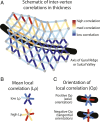Imaging local genetic influences on cortical folding
- PMID: 32170019
- PMCID: PMC7132284
- DOI: 10.1073/pnas.1912064117
Imaging local genetic influences on cortical folding
Erratum in
-
Correction for Alexander-Bloch et al., Imaging local genetic influences on cortical folding.Proc Natl Acad Sci U S A. 2020 Jun 16;117(24):13849. doi: 10.1073/pnas.2009131117. Epub 2020 Jun 8. Proc Natl Acad Sci U S A. 2020. PMID: 32513695 Free PMC article. No abstract available.
Abstract
Recent progress in deciphering mechanisms of human brain cortical folding leave unexplained whether spatially patterned genetic influences contribute to this folding. High-resolution in vivo brain MRI can be used to estimate genetic correlations (covariability due to shared genetic factors) in interregional cortical thickness, and biomechanical studies predict an influence of cortical thickness on folding patterns. However, progress has been hampered because shared genetic influences related to folding patterns likely operate at a scale that is much more local (<1 cm) than that addressed in prior imaging studies. Here, we develop methodological approaches to examine local genetic influences on cortical thickness and apply these methods to two large, independent samples. We find that such influences are markedly heterogeneous in strength, and in some cortical areas are notably stronger in specific orientations relative to gyri or sulci. The overall, phenotypic local correlation has a significant basis in shared genetic factors and is highly symmetric between left and right cortical hemispheres. Furthermore, the degree of local cortical folding relates systematically with the strength of local correlations, which tends to be higher in gyral crests and lower in sulcal fundi. The relationship between folding and local correlations is stronger in primary sensorimotor areas and weaker in association areas such as prefrontal cortex, consistent with reduced genetic constraints on the structural topology of association cortex. Collectively, our results suggest that patterned genetic influences on cortical thickness, measurable at the scale of in vivo MRI, may be a causal factor in the development of cortical folding.
Keywords: cerebral cortex; cortical folding; cortical thickness; genetic correlation; structural MRI.
Copyright © 2020 the Author(s). Published by PNAS.
Conflict of interest statement
The authors declare no competing interest.
Figures




References
Publication types
MeSH terms
Grants and funding
LinkOut - more resources
Full Text Sources

